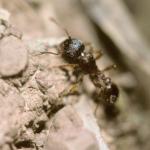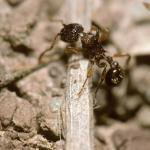This is one of twelve British ant species in the genus Myrmica. Individual workers of M. lobicornis tend to be more robust, rugose and darker reddish brown than other commonly encountered Myrmica; they can occasionally appear almost black although there is significant variation in colour. The available keys provide fairly clear characters for accurate determination of this species; the most pronounced feature is the conspicuous vertical flange at the bend of the antennal scape. Myrmica lobicornis is one of the least aggressive species of Myrmica and is unlikely to use its sting.
Myrmica lobicornis has a widely scattered distribution throughout England, Wales and Scotland, although curiously there is no record of this species from Ireland. This ant is found from Arctic Scandinavia south to southern Europe, and east to the Caucasus and central Asia.
Not listed in either Shirt ( 1987) or Falk (1991). The shortage of recent records is probably a result of low recording effort, particularly in upland northern England and Scotland where it is expected to be more plentiful than indicated on the map.
In Britain, M. lobicornis tends to occur in fairly undisturbed natural and semi-natural habitats such as upland moor, lowland heath, rough grassland and open woodland. The highest population densities are found more commonly in upland and mountainous areas.
As with other Myrmica, the mating flights of this species occur in late summer.
Nests are commonly in the ground or under stones, with no obvious above surface structure. Colonies are relatively small with a few hundred to a few thousand individuals. M. lobicornis is more commonly monogynous than most other Myrmica.
Workers of M. lobicornis usually forage individually in a relatively slow and hesitant manner compared with other Myrmica. They forage mainly on the ground rather than in vegetation and are rarely found tending Homoptera for their honeydew. Most of their food appears to be scavenged invertebrate material although little is known about the feeding habits of this species.
No parasitic ant species is known to be associated with M. lobicornis.
1998



